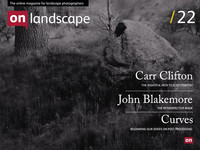Book review

Tim Parkin
Amateur Photographer who plays with big cameras and film when in between digital photographs.
I’ll admit to being heavily influenced by my workshop with John Blakemore and this has probably biased my review of this book a bit. However, given that declaration of bias, I will also say that this is one of the most beautifully printed books I own, necessarily so if it is to reflect the prints that I saw in person.
The good news is it gets close - as close as a book can get I would say. Let’s start with the book itself though. Clothbound in a cool grey and including a print on the front cover (the limited edition includes an 8x10 hand print although is £150).
The first pictures we see are a surprising set of colour photographs from 1963-1968, shoot through pictures of trees and grasses with the setting sun a blurry fireball as the backdrop, quite contemporary in feel.
The book is a chronicle of sorts, with comments giving brief context. It begins in Tripoli, his national service posting, and an inspiration came in the Picture Post (The Family of Man) and it continues at his home in Hillfields, all street photography and theatre.
Then the start of his real journey, the dislocation of living in the big city triggering memories of landscape and the start of exploration of photography as a metaphor.
The Lila and Wind series is the heart of his landscape work and seen as a product of their time, they are quite revolutionary. American photography had visited these more abstract ideas but it is rare to see it in British art of the time and bears comparison with Edward Weston and is contemporaneous with Minor White.
It is probably Minor White that is the easiest, if not necessarily the best comparison as they both had a great influence on the photographers they taught and were looking deeper into the ideas of photography than those around them. Blakemore's is quintessentially English against White’s liberal and zen underpinnings though.
The prints within this section are exquisite; many of them printed in just the lowest of tones (see Blakemore’s ‘Black and White Photography Workshop’ for a great overview of the techniques behind many of these photographs) and some, especially the Wind series, printed as light as air; suggesting the ephemeral.
In the 80s, his studio work began in earnest, a retreat from the landscape and it’s complexity, only to have this complexity reappear as projects continued. Leaves, branches, garden detritus; pampus grasses in the paper against windows and then, Thistles - the start of a series. Again, the prints are exquisite and as far from Ansel ‘must have every zone’ Adams as you can image (damn - and I was almost sounding erudite for a while then).
We also see commissioned work that looks as if it could appear in one of Faye Godwin’s later books but which play with the previous Wind projects yet contrast the proximity of potential nuclear dumping grounds with the beauty of the area - his only overtly political work.
And then to Tulips… I have to say that it was John talking about Wind/Lila and then Tulips that made me realise that there was so much more to photography than the individual photograph. His continuous interpretation and discovery and reformulation of the project is amazing. It becomes so much more than tulips.
In the latter part of the book, we have his work with handmade books. I’m not completely convinced by the end product but I do admire the philosophy behind it, a process of distilling photography down to the immediate taking and production of a set of pictures for consumption; the process of ordering, creation and binding as much part of the creative process as printing was in previous works.
Saying that - his book of Schmaltz the cat is fantastic. I think all photographers who cohabit with cats will have taken the occasional picture but John takes it, as always, to another level.
The only book project that really hooked me is ‘seeing light, chasing rainbows’, a selection of photographs of cast light around his house. This revealed an exploration and moments of discovery.
There is also, at the end, an excellent essay by Jane Fletcher, lacking in typical artistic hyperbole and philosophic ephemera. It approaches John’s work directly and is all the better for it. And finally a chronology, list of exhibitions and shows and a few sunsets (there - sunsets! Even John Blakemore does sunsets! They must be cool again!)
I would say that for the photographer interested in metaphor & project or just exquisite black and white work, this book and ‘Workshop’ are very highly recommended.
You can buy the book from Beyond Words (click here to view the book).
There is also a book signing and talk at two events in Scotland in October.
On Sunday 23 October at 2 p.m. at Street Level Photoworks, Trongate 103, Glasgow G1 5HD, he will be giving a talk and signing copies of the book.
On Monday 24 October there will be a further talk and signing (organized by Beyond Words photographic books) at McDonald Road, 2 McDonald Road, Edinburgh EH7 4LU at 6.15 p.m.
A limited number of signed books will be available from Beyond Words for those not able to make the event.
For further information, or to reserve a place, contact Malcolm Dickson for the Glasgow event or Neil McIlwraith for the Edinburgh event.
There is also an exhibition on at Hoopers Gallery in London which will be running until the 14th October. If you can make it I promise you won't be disappointed.
Read articles on:
- John Blakemore Book Binding and Sequencing Workshop
- John Blakemore Master Photographer
- Black and White Photographers Workshop – John Blakemore
- John Blakemore talk at On Landscape Conference
[/s2If]

